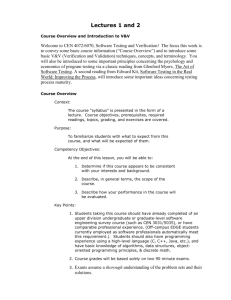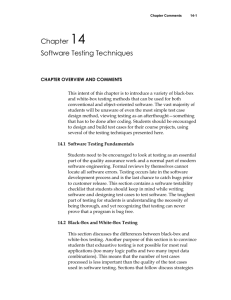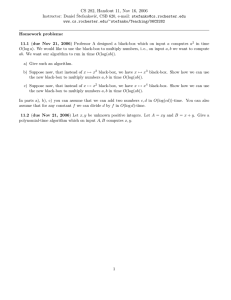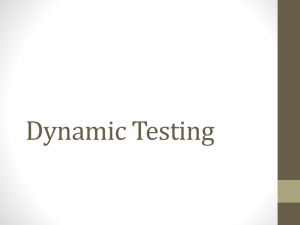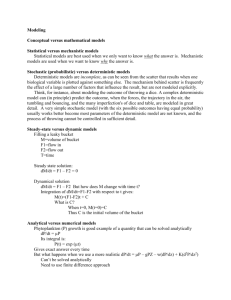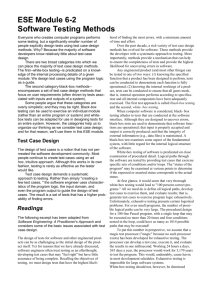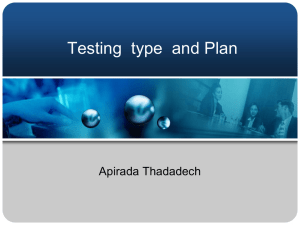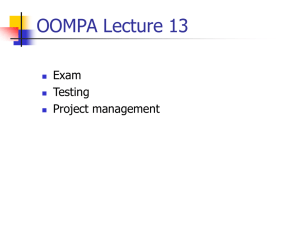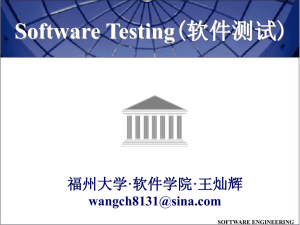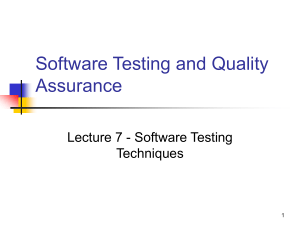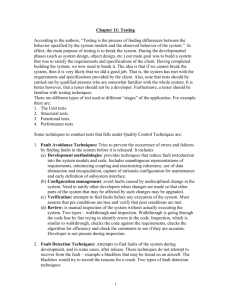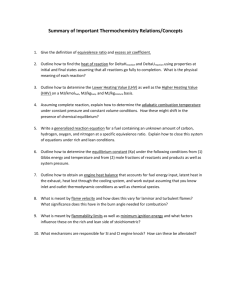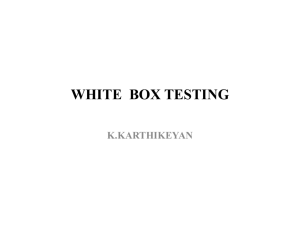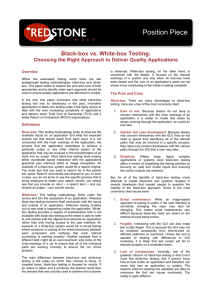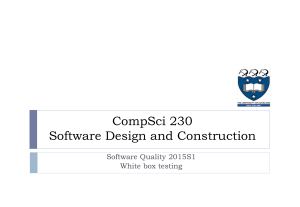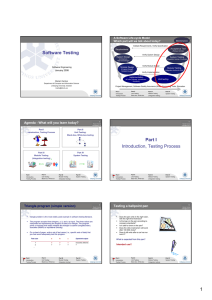Chapter 17 – Software Testing Techniques
advertisement
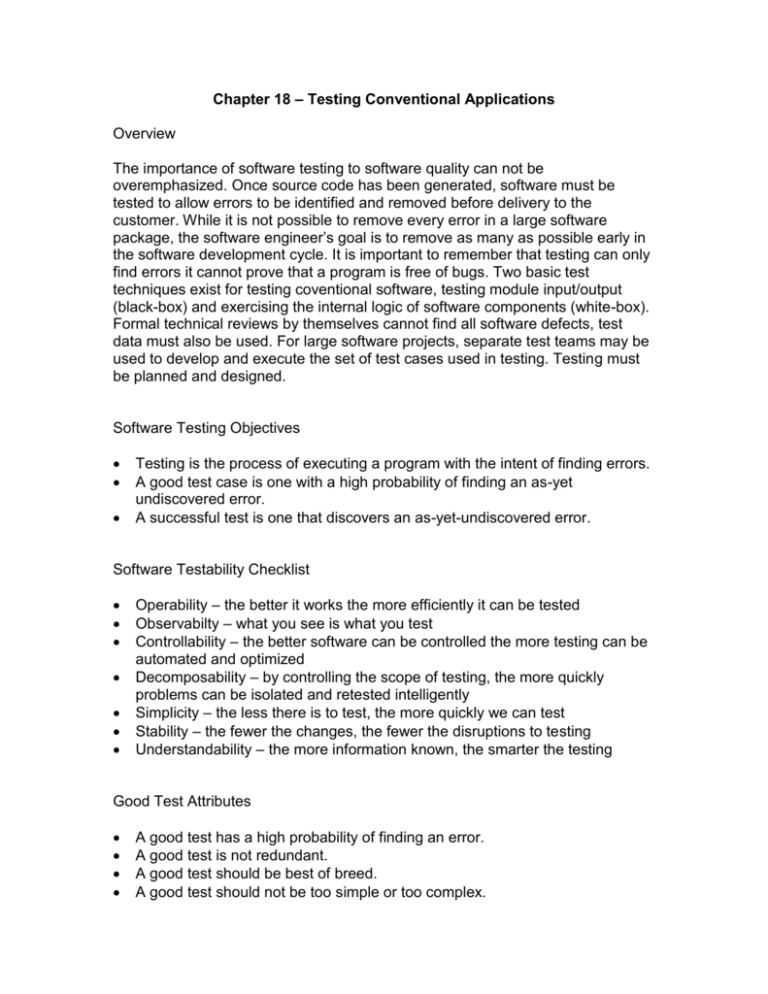
Chapter 18 – Testing Conventional Applications Overview The importance of software testing to software quality can not be overemphasized. Once source code has been generated, software must be tested to allow errors to be identified and removed before delivery to the customer. While it is not possible to remove every error in a large software package, the software engineer’s goal is to remove as many as possible early in the software development cycle. It is important to remember that testing can only find errors it cannot prove that a program is free of bugs. Two basic test techniques exist for testing coventional software, testing module input/output (black-box) and exercising the internal logic of software components (white-box). Formal technical reviews by themselves cannot find all software defects, test data must also be used. For large software projects, separate test teams may be used to develop and execute the set of test cases used in testing. Testing must be planned and designed. Software Testing Objectives Testing is the process of executing a program with the intent of finding errors. A good test case is one with a high probability of finding an as-yet undiscovered error. A successful test is one that discovers an as-yet-undiscovered error. Software Testability Checklist Operability – the better it works the more efficiently it can be tested Observabilty – what you see is what you test Controllability – the better software can be controlled the more testing can be automated and optimized Decomposability – by controlling the scope of testing, the more quickly problems can be isolated and retested intelligently Simplicity – the less there is to test, the more quickly we can test Stability – the fewer the changes, the fewer the disruptions to testing Understandability – the more information known, the smarter the testing Good Test Attributes A good test has a high probability of finding an error. A good test is not redundant. A good test should be best of breed. A good test should not be too simple or too complex. Test Case Design Strategies Black-box or behavioral testing – knowing the specified function a product is to perform and demonstrating correct operation based solely on its specification without regard for its internal logic White-box or glass-box testing – knowing the internal workings of a product, tests are performed to check the workings of all possible logic paths White-Box Testing Questions Can you guarantee that all independent paths within a module will be executed at least once? Can you exercise all logical decisions on their true and false branches? Will all loops execute at their boundaries and within their operational bounds? Can you exercise internal data structures to ensure their validity? Basis Path Testing White-box technique usually based on the program flow graph The cyclomatic complexity of the program computed from its flow graph using the formula V(G) = E – N + 2 or by counting the conditional statements in the program design language (PDL) representation and adding 1 Determine the basis set of linearly independent paths (the cardinality of this set id the program cyclomatic complexity) Prepare test cases that will force the execution of each path in the basis set. Control Structure Testing White-box technique focusing on control structures present in the software Condition testing (e.g. branch testing) – focuses on testing each decision statement in a software module, it is important to ensure coverage of all logical combinations of data that may be processed by the module (a truth table may be helpful) Data flow testing – selects test paths based according to the locations of variable definitions and uses in the program (e.g. definition use chains) Loop testing – focuses on the validity of the program loop constructs (i.e. simple loops, concatenated loops, nested loops, unstructured loops), involves checking to ensure loops start and stop when they are supposed to (unstructured loops should be redesigned whenever possible) Black-Box Testing Questions How is functional validity tested? How is system behavior and performance tested? What classes of input will make good test cases? Is the system particularly sensitive to certain input values? How are the boundaries of a data class isolated? What data rates and data volume can the system tolerate? What effect will specific combinations of data have on system operation? Graph-based Testing Methods Black-box methods based on the nature of the relationships (links) among the program objects (nodes), test cases are designed to traverse the entire graph Transaction flow testing – nodes represent steps in some transaction and links represent logical connections between steps that need to be validated Finite state modeling – nodes represent user observable states of the software and links represent transitions between states Data flow modeling – nodes are data objects and links are transformations from one data object to another Timing modeling – nodes are program objects and links are sequential connections between these objects, link weights are required execution times Equivalence Partitioning Black-box technique that divides the input domain into classes of data from which test cases can be derived An ideal test case uncovers a class of errors that might require many arbitrary test cases to be executed before a general error is observed Equivalence class guidelines: 1. If input condition specifies a range, one valid and two invalid equivalence classes are defined 2. If an input condition requires a specific value, one valid and two invalid equivalence classes are defined 3. If an input condition specifies a member of a set, one valid and one invalid equivalence class is defined 4. If an input condition is Boolean, one valid and one invalid equivalence class is defined Boundary Value Analysis Black-box technique that focuses on the boundaries of the input domain rather than its center BVA guidelines: 1. If input condition specifies a range bounded by values a and b, test cases should include a and b, values just above and just below a and b 2. If an input condition specifies and number of values, test cases should be exercise the minimum and maximum numbers, as well as values just above and just below the minimum and maximum values 3. Apply guidelines 1 and 2 to output conditions, test cases should be designed to produce the minimum and maxim output reports 4. If internal program data structures have boundaries (e.g. size limitations), be certain to test the boundaries Orthogonal Array Testing Black-box technique that enables the design of a reasonably small set of test cases that provide maximum test coverage Focus is on categories of faulty logic likely to be present in the software component (without examining the code) Priorities for assessing tests using an orthogonal array 1. Detect and isolate all single mode faults 2. Detect all double mode faults 3. Mutimode faults Model-Based Testing Black-bix testing technique using information contained in the requirements model as a basis for test case generation Steps for MBT 1. Analyze an existing behavior model for the software or create one. 2. Traverse behavioral model and specify inputs that force software to make transition from state to state. 3. Review behavioral model and note expected outputs as software makes transition from state to state. 4. Execute test cases. 5. Compare actual and expected results (take corrective action as required). Specialized Testing Graphical User Interface (GUI) – test cases can be developed from behavioral model of user interface, use of automated testing tools is strongly recommended. Client/Sever Architectures – operational profiles derived from usage scenarios are tested at three levels (client application “disconnected mode”, client and server software without network, complete application) Applications function tests Server tests Database tests Transaction tests Network communications tests Documentation and Help Review and inspection to check for editorial errors Black-Box for live tests o Graph-based testing to describe program use o Equivalence partitioning and boundary value analysis to describe classes of input and interactions Real-Time Systems 1. Task testing – test each task independently 2. Behavioral testing – using technique similar to equivalence partitioning of external event models created by automated tools 3. Intertask testing – testing for timing errors (e.g. synchronization and communication errors) 4. System testing – testing full system, especially the handling of Boolean events (interrupts), test cased based on state model and control specification Testing Patterns Provide software engineers with useful advice as testing activities begin Provide a vocabulary for problem-solvers Can focus attention on forces behind a problem (when and why a solution applies) Encourage iterative thinking (each solution creates a new context in which problems can be solved
